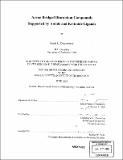| dc.contributor.advisor | Christopher C. Cummins. | en_US |
| dc.contributor.author | Diaconescu, Paula L. (Paula Loredana), 1976- | en_US |
| dc.contributor.other | Massachusetts Institute of Technology. Dept. of Chemistry. | en_US |
| dc.date.accessioned | 2006-03-24T16:10:25Z | |
| dc.date.available | 2006-03-24T16:10:25Z | |
| dc.date.copyright | 2003 | en_US |
| dc.date.issued | 2003 | en_US |
| dc.identifier.uri | http://hdl.handle.net/1721.1/29638 | |
| dc.description | Thesis (Ph. D.)--Massachusetts Institute of Technology, Dept. of Chemistry, 2003. | en_US |
| dc.description | Vita. | en_US |
| dc.description | Includes bibliographical references. | en_US |
| dc.description.abstract | Chapter 1: The Intriguing Geometric and Electronic Structure of Arene-Bridged Diuranium Tetrakisamido Complexes The focus of this chapter is to characterize and contextualize the bridged arene complex (-toluene)U2(N[t-Bu]Ar)4 (lb2-gl-toluene, Ar = 3,5-C6H3Me2). To do so, lb2-g-toluene is compared extensively with the mononuclear complexes (THF)U(N[1Ad]Ar)3 (2a-THF, THF = tetrahydrofuran), JIU(N[t-Bu]Ar)3 (la-I), IU(N['Ad]Ar)3 (2a-I), and Me3SiNU(N[1Ad]Ar)3 (2a- NSiMe3). In order to understand the properties of a unique compound such as lb2-pg-toluene, the rest of the series is based on classical uranium amide compounds. The syntheses, structures (X-ray crystal structures and solution behavior based on variable temperature, VT, NMR data), spectroscopic (X-ray absorption near-edge structure, XANES, and electronic absorption - UV- vis-NIR) and magnetic properties are discussed and interpreted with reference to results of density functional theory (DFT) calculations performed on model compounds. Reactivity studies of lb2-p-toluene are then presented and analyzed. Chapter 2: Arene Bridged Diuranium Complexes Supported by a Ketimide Ligand: Even and Odd Electron Redox Pairs The ketimide ligand NC[t-Bu]Mes (Mes = 2,4,6-C6H2Me3) employed in the present study allows for retention of three supporting ligands per uranium, giving rise to a three-legged piano stool geometry, and it also allows for incorporation of potassium ions as tight ion pairs. The generality of such a ligand is well supported by the existence of the two types of compounds M2(g-arene)U2(NC[t-Bu]Mes)6 (M2-32-g-arene, M = Na, K) and K-32-pt-arene, when the arene is naphthalene, biphenyl, trans-stilbene, or p-terphenyl. | en_US |
| dc.description.abstract | (cont.) When toluene or benzene is the bridging arene, only odd electron species are formed including symmetrical complexes, K21-32- -arene', and asymmetrical complexes, K(DME)-32-g1-arene' (arene' = benzene, toluene). The reactivity patterns observed for the bridging arene ketimide compounds are complicated by loss of an alkali metal ion (K2-32-jg-arene with PhSSPh) or by additional redox processes (K-32-gl-arene with PhNNPh), but interesting products have been isolated. By contrast, the reaction of K2-32-g-arene with 1,3,5,7-cyclooctatetraene appears to be straightforward leading to K-3-COT. Compound 32-I-COT obtained from reaction of K-3-COT with 3-I-DME is an interesting example of an inverted sandwich and can be referred to as "inverted uranocene". Chapter 3: Uranium 2,2'-Bipyridyl Complexes Supported by Amide and Ketimide Ligands The synthesis and characterization of (bipy)2U(N[t-Bu]Ar)2 (lb-(bipy)2, bipy = 2,2'-bipyridyl, Ar = 3,5-C6H3Me2), (bipy)U(N[1Ad]Ar)3 (2a-bipy), (bipy)2U(NC[t-Bu]Mes)3 (3-(bipy)2, Mes = 2,4,6-C6H2Me3), and IU(bipy)(NC[t-Bu]Mes)3 (3-I-bipy) are reported. X-ray crystallography indicates that bipy coordinates as a radical anion in lb-(bipy)2 and 2a-bipy, and as a neutral ligand in 3-I-bipy. In 3-(bipy)2, one of the ligands is best viewed as a radical anion, while the other as a neutral ligand. These results are supported by NMR spectroscopy results of exchange experiments with 4,4'-dimethyl-2,2'-bipyridyl (dmb) and optical spectroscopy. In all complexes uranium is assigned a +4 formal oxidation state. | en_US |
| dc.description.statementofresponsibility | by Paula L. Diaconsescu. | en_US |
| dc.format.extent | 267 p. | en_US |
| dc.format.extent | 9929610 bytes | |
| dc.format.extent | 17887818 bytes | |
| dc.format.mimetype | application/pdf | |
| dc.format.mimetype | application/pdf | |
| dc.language.iso | eng | en_US |
| dc.publisher | Massachusetts Institute of Technology | en_US |
| dc.rights | M.I.T. theses are protected by copyright. They may be viewed from this source for any purpose, but reproduction or distribution in any format is prohibited without written permission. See provided URL for inquiries about permission. | en_US |
| dc.rights.uri | http://dspace.mit.edu/handle/1721.1/7582 | |
| dc.subject | Chemistry. | en_US |
| dc.title | Arene bridged diuranium compounds supported by amide and ketimide ligands | en_US |
| dc.type | Thesis | en_US |
| dc.description.degree | Ph.D. | en_US |
| dc.contributor.department | Massachusetts Institute of Technology. Department of Chemistry | |
| dc.identifier.oclc | 53398747 | en_US |
